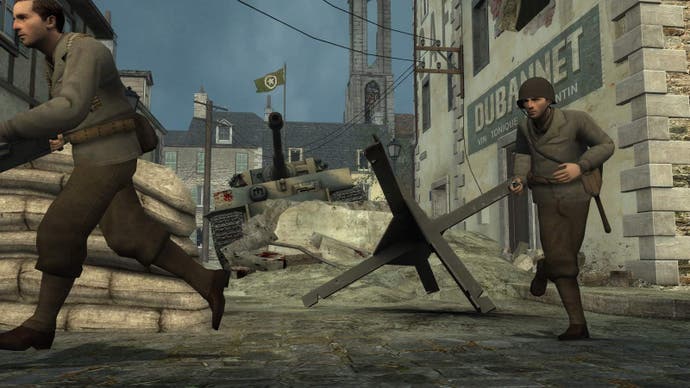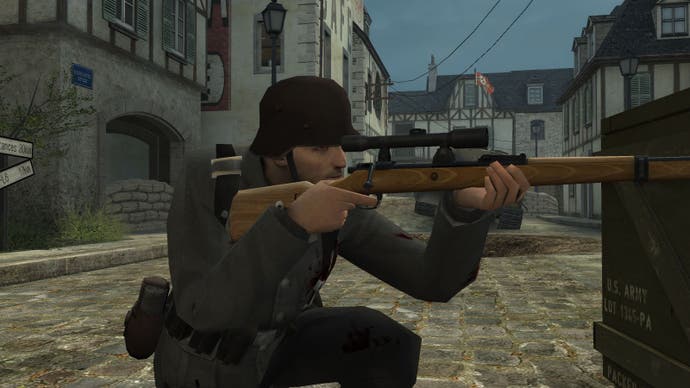Day of Defeat: Source
They think it's all uber.
Ah, the ruined landscape of wartorn France.
Speaking of lovely places where shootings happen, I was in Croydon on Saturday and found myself talking to a friend from one of those paper magazine things about this here review. "Ah, you just need a couple of war stories for that," he said, truthfully. But, I thought to myself, perhaps a little cynically?
As it turns out, he couldn't have been more right. Following a tolerable pock- and occasionally spack-marked period of adjustment, Day of Defeat: Source is a delightful memory machine, rumbling along and preparing to catapult you to glorious victory or heartbreaking defeat. The good thing being, of course, that nobody has to die for it. Unless you're playing it in East Croydon station, obviously, in which case it's only a matter of time.
My stories are several and varied, but obviously I'd rather talk about the ones where I was a success rather than that one where I walked up the stairs, turned inside a doorway, instinctively shot one of my snipers in the back of the head and then bounced a grenade into my own face to celebrate.
So there I was, fighting the gritty war for the Fuhrer (I'd decided to switch allegiances because the war cries were more amusing), sneaking around a railway yard trying to get a bead on the enemy. DOD works by putting you and your comrades on one side of an asymmetrical map and the enemy on the other, a bit like something out of Counter-Strike, and then having the two of you charge forth and break waves of lead across each other's faces to establish the initial balance of control; thenceforth you respawn and charge back into the fray, trying to help your team control its share of the map's five capture points - big flags - and perhaps seize the others. Whoever has all five wins the round, netting lots of points.

In the yard, we did not have all five. We had two. They had three.
I'd been getting better as the round progressed, and figuring out where we all were. The right side, down the train tracks toward their spawn point, was a total no-go. Anybody who ventured there was sniper fodder - even if you just wanted to nip inside the tempting doorway near the top, or chuck a grenade. The left was a bit more solid - it housed one of our two points - but they were coming close to breaking through thanks to their control of a central hall where half the walls had been ripped away.
I decided I'd had enough of this pansy sitting around containment nonsense. This is World War II! Containment is a proven failure! So I switched to assault class - which, with its machinegun-that-is-effective-even-while-moving is handily suited to suicide runs - and darted forward. Surprising the enemy with my unexpected guile (read: reckless behaviour), I raced past their central stronghold, even avoiding the crosshairs of a rubble-clad heavy machinegunner, and dived through the blown-off corner of a building into someone's kitchen. Through the doorway and down some stairs I went, leaving nothing to chance by sending a smoke grenade off ahead of me (following my customary routine of bouncing it off a wall and my own head), dove outside and quickly into another nearby doorway, and followed the carpeted ventricles of the interior toward what I knew to be the throbbing heart of the Allied campaign against me. Emerging already semi-delirious into sunlight again, blinking away the HDR effect, I took two of the Yanks entirely by surprise. Daring to lower my weapon to sprint, I raced up a hill and took the crucial spawn control point, even managing to mow down a pair of enemy reinforcements who emerged angry and organised several seconds latter.
Simultaneously, word of my remarkable endeavours spread over the wires (mainly because I typed "Allie spawn gto cap othrs ffs" in a mad panic), and through a feat of Hitlerean boisterousness the others took the central point, and managed to hold it long enough to claim the square as well, thus giving us the round completely - a success that hinged entirely on my courage, quick reactions and ability to type semi-legibly under fire.
As the music of success died away, we all respawned and started again.

I may have been behaving impulsively, and ignoring team efforts, but the thing I've found about DOD is that while it encourages teamplay - and truly organised teams thrive - it's aware that most people coming to it will do so individually, and is set up just so to oil the rails for these. For example, when reviewers say "enemy reinforcements" in the manner I just did, it's usually hyperbolic; here it's literal; when you respawn, the game makes sure you respawn with those who have just perished, allowing you to form impromptu groupings even if you're not actually communicating. With such a high turnover rate in terms of death and a reasonably short route back to battle, you typically find yourself in groups.
Equally, each level is a warren of tightly wound corridors knotted together through crumbling houses surrounding sniper alleys, courtyards and street-style broadways that allow for more concentrated fighting. In this sense, it not only appeals to those who wish to group up and watch over each other, but it allows you to survive - and enjoy yourself - just exploring the branches of each map. What I enjoy most about the maps though is that above these things, they also have a Counter-Strike-style propensity toward establishing choke points, and routes to them. With so many different paths, you can be killed from virtually anywhere, but the crucial thing about that is that with a bit of thought - and observation of where you died - you can also kill from anywhere. When you go down and the camera swings round to reveal who dunnit, you're given a good idea how to get back at them; in this sense it also discourages extended periods of camping.
Equally unlike CS, you can actually enjoy the tight, jack in the box encounters that typically punctuate any given round - partly because you know you'll be back, and that works, and partly because the levels are designed in such a way that laying in wait can be to you and your team's disadvantage. The classes add to the drama, too. Though generic-sounding, they tend toward certain teamplay FPS archetypes in such a way that you're catered for whether you enjoy melee-style fights, more laboured, thoughtful approaches or working in units - and where an experienced chap with a big rifle and a Desert Eagle in CS could outdo an AK-47-toting terrorist in many situations, near or far, anybody moving through the hallways of a DOD map with a rifle coming up against an assault trooper is in real trouble.
Inevitably, a lot of your feeling for DOD is likely to be determined by how it behaves during that crucial period of adoption and, like CS, it can be a trying time where the responsibility is very much on you to do the adopting. Initially, you will be overawed and die plenty - particularly if you lack the paranoia of the average CS veteran. Spend a few minutes in spectator mode acquainting yourself, though, then take a few stumbling steps and you will find some way of making an impact - and even enjoying it as you only come close, and bullets ram into finely modelled walls around you during the awkward fumble of close quarters firefights. It really is the closest I've come to the visceral cuts of a film like Saving Private Ryan; where panic dominates the closed spaces and calculation and bravado rules over distance.

To that end Valve gets much right. Graphical work is lovely. It's not so much the definition, but the volume and diversity of the details. Each scene feels blown apart, but there's always neat organisation within the chaos; well-designed war, in other words.
Some will complain that there are only six maps (at launch there were four; with the game now on UK shelves as of this month, it's six) and that veterans of DOD for Half-Life 1 will recognise the ones there are. But in actuality familiarity breeds new interest, as is the case whenever CS inherits a new Sourced playground. And the six there are - Argentan, Anzio, Avalance, Donner, Flash and Kalt - are uniformly excellent, with the potential for more as Valve continues to toy with its creation. Recent additions suggest the design quality is very consistent.
In terms of scale, it barely comes up to Battlefield's ankles, and in terms of tactics and tension it can't beat Counter-Strike, but once you've spent a few hours on a server of 20 or so people, you'd have to want not to enjoy it to fail to - and your own war stories are an inevitable byproduct. With well-policed servers abounds to top things off, it's quietly brilliant - and at a terrific price. Tours of Normandy and Croydon out of the way, that's my story.


